
In memory of a French two-wheel hero
Olivier Chevallier was a French motorcycle racer. He was killed on Sunday, April 6th, 1980 while racing for the “Moto Journal 200” on the Paul Ricard racetrack. Olivier was one of the most popular characters in the Continental Circus. This year marks the fortieth anniversary of his death. On this occasion we wanted to do our part to ensure that one of the most influential figures in France in motorcycle racing in the 1970s should not be forgotten.

Far too many incorrect “informations” on the Internet
Unfortunately, wiki and similar Internet portals are often quite helpful, but far too often imprecise and sometimes simply flawed. Therefore, many reports that we found on the Internet about Olivier Chevallier are more than incomplete in numerous respects and in some cases incorrect in terms of content. For example, his brother Alain and his almost namesake named Roger Chevalier (note the one “L” in the surname instead of two) were often confused. The latter was French champion up to 500 cm³ in 1963 (national category). Since we have, among other historic material, a huge collection of French motor and racing journals from the previous century, we were grateful for this obituary.

Birth and origin
Olivier Chevallier was born in Vendôme, France in 1949. This is a small French town with a little over 15 thousand inhabitants in the Loir-et-Cher department in the Center-Val de Loire region. Vendôme lies on the Loir River, which surrounds the old town with two arms. The small town is roughly halfway between Le Mans and Orléans, around 170 kilometers southwest of Paris. He was initially promoted by his father, a hobby motorcyclist. It was he who took the young Olivier with him from time to time to attend the races of Le Mans and Linas-Montlhéry. As a result, the son became enthusiastic about motorsport at an early age. He was the fifth of a family with eight children. This explained why he remained very close to the family throughout his life.

Olivier’s brother Alain
His older brother Alain (not like he was wrongly claimed in some forums, but a Roger Chevalier won the French 500 cc championship on Triumph) became a motorcycle designer. In 1982 Didier de Radiguès drove to victory at the 350 cc Grand Prix of Yugoslavia with a chassis designed by Chevallier and a Yamaha engine. In the world championship, the Belgian was 350 runner-up behind the German Toni Mang (Kawasaki). His Chevallier-Yamaha team-mate Eric Saul won the Austrian Grand Prix and finished the championship in fourth place.
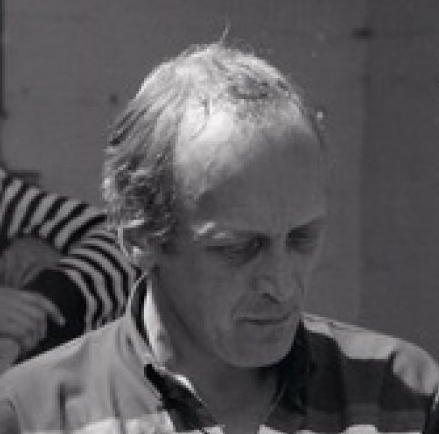
Many more successes in 1983
In the following year, all three drivers of Chevallier’s team with de Radiguès, Thierry Espié and Jean-François Baldé (both France) landed in the top ten of the 250 cc World Championship. Baldé also won the 250 South African Grand Prix in 1983. After 1986 no Chevallier-Yamaha took part in Grand Prix races. Alein Chevallier later also worked as a designer for the French brand Voxan. He died of cancer on October 3, 2016 at the age of 68.

Enthusiasm for racing and the first steps
As a sports fan, the young Chevallier started racing go-karts as a teenager. Olivier’s first small motorcycle of his own was a 50cc Motobi Sport, which he bought with his savings at the age of 16. A short time later he switched to racing and took part in the “Jeunes Tigres Challenge” in 1966 at the age of 17. The series, sponsored by the mineral oil and fuel company Esso, was founded to discover and promote young talent. At the time, it was supervised by Georges Monneret, a French motorcycle racer known since the 1930s. It was important for the young drivers to promote them over the entire racing season and to support them in their development. Olivier Chevallier won the “Young Tiger” title. This laid the foundation for his racing career.
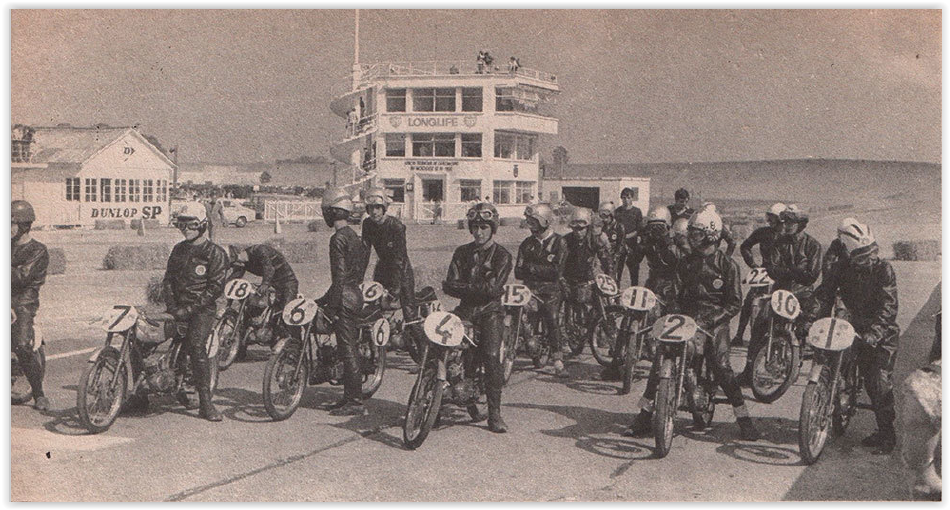

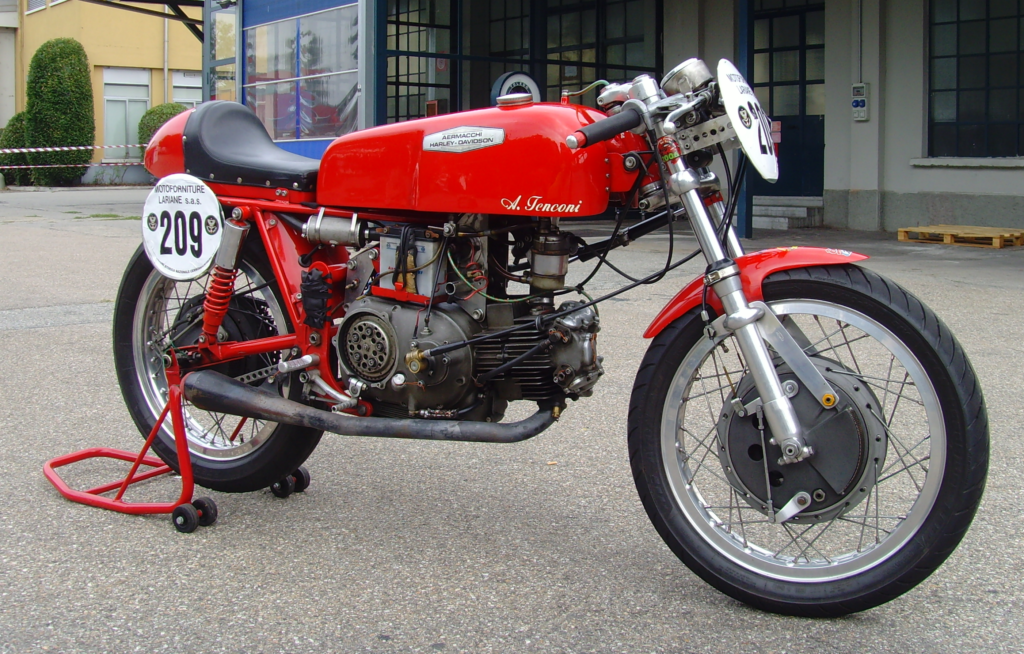
Further steps and a short break before returning
This was followed by national races in the 250 cm³ category with a 1-cylinder 4-stroke 250 cm³ Aermacchi Ala D’Oro. With that, Olivier Chevallier had some successes in 1967. At the end of the season, however, he decided to give up racing for a while and resume his architecture studies. But the passion for racing continued to burn in him and that is why he returned to the slopes after 2 years. Olivier won the French championship on a Yamaha TD1C 250 with victories at Magny-Cours, Le Mans and Linas-Montlhéry.
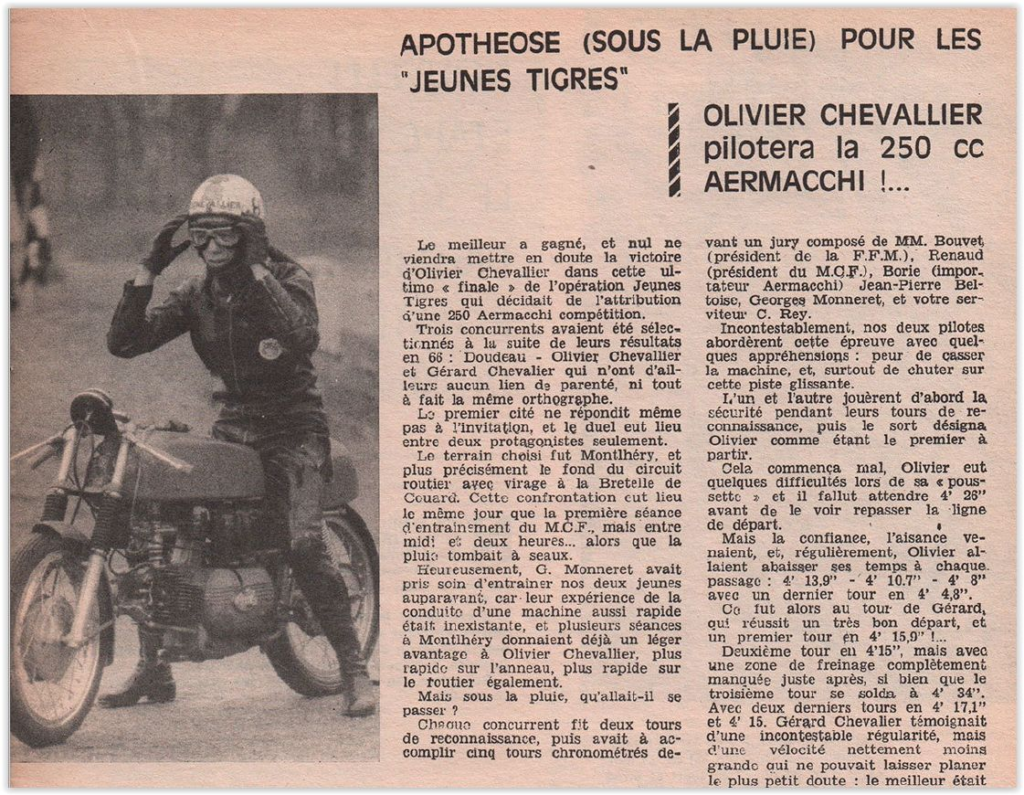
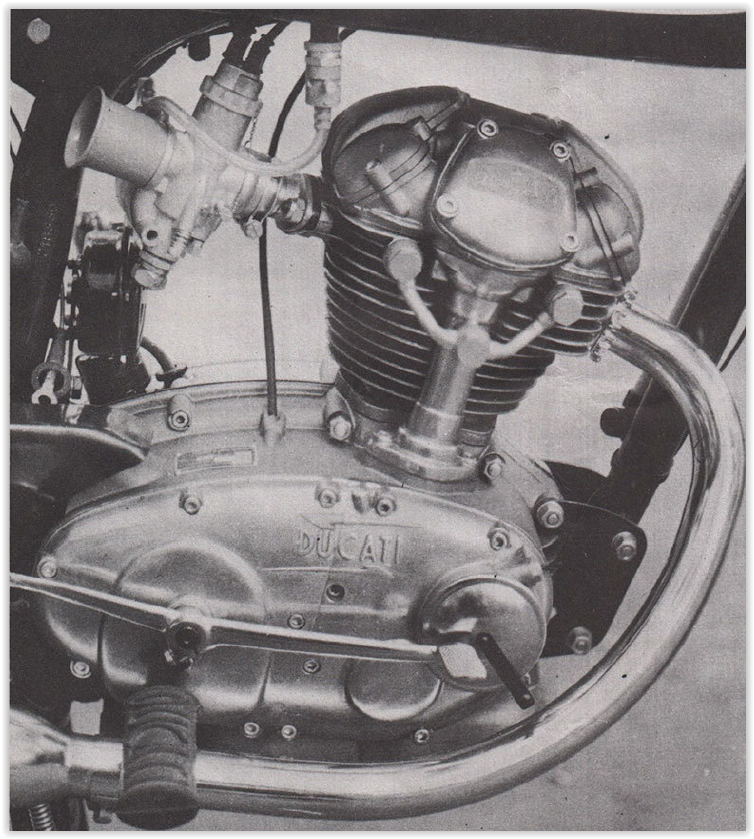
First international success
In September 1970 Olivier Chevallier was hired by the British Motorbike Racer Peter Darvill. The aim was to replace the standard driver Norman Price on a Honda 750. At the side of Darvil, he therefore took part in the prestigious Bol d’Or in Linas-Montlhéry in September. The Bol d’Or (French golden bowl) has been one of the most famous 24-hour motorcycle races since the 1920s. It was first played in 1922 in Vaujours en Seine St Denis. The Bol d’Or usually takes place on the third weekend in September. The race usually starts on Saturday at 3 p.m. and ends on Sunday at 3 p.m. The tradition of this event, with an interruption during the Second World War from 1940 to 1946, continues today. The British-French pairing Darvill-Chevallier took a sensational 2nd place overall behind the winners Tom Dickie / Paul Smart on a works Triumph 750. By now, at the latest, the 21-year-old Olivier was known as a racing driver throughout the country and beyond its borders.
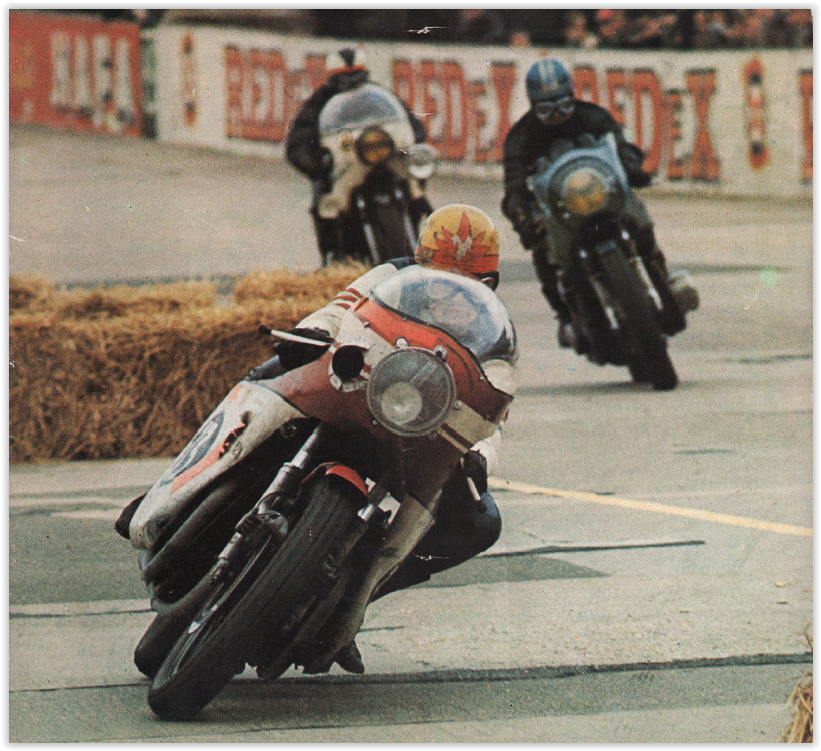
Extract from the list of winners from the 34th Bol d’Or in Montlhéry from September 12th to 13th, 1970
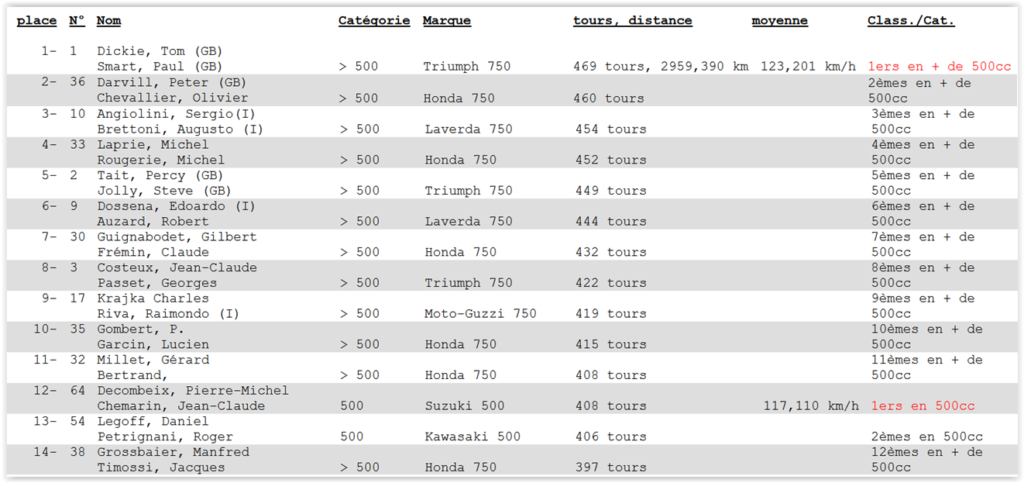
Hard times in the early 1970s
After not only mediocre results in the 1971 season, “Oli” Chevallier decided that he should no longer rely on his father alone to continue his racing career. With that began his almost endless search for sponsorship money. After all, he already had considerable successes in national and international races. 3rd place in Linas-Monthlery in the 125 and 250 class was followed by 2nd place in Reims in the 250 cm³ category. On June 20, 1971, a third place in the 350 to 500 cm³ class in Magny-Cours was added. In the autumn Olivier got a second place in the 250s, as well as two third places (250 cm³ and 350-500 cm³) in Linas-Monthléry. Thanks to his persistence, he managed to move up to the “Continental Circus” in GP sport in 1972. He bought two Yamaha Production-Racer motorcycles to compete in the 250 and 350cc categories.
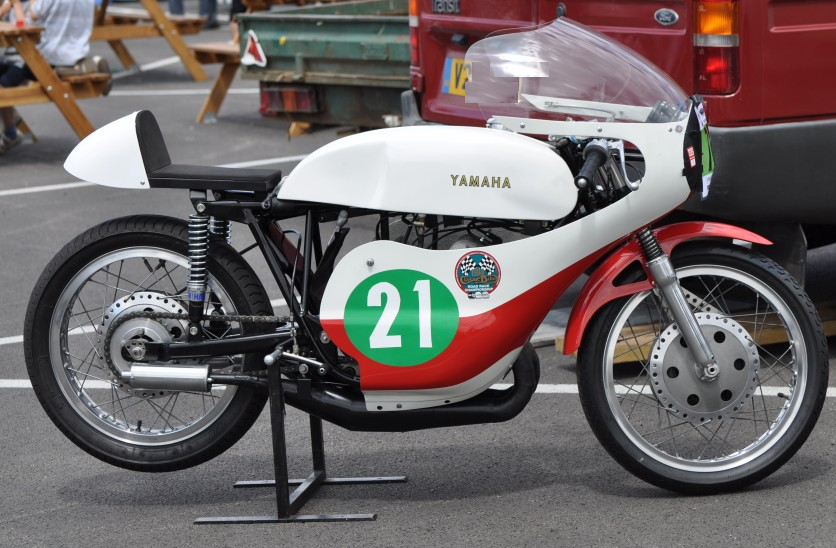
In vain travel to Germany
For almost all pilots in the 1970s, times were usually extremely tough for private drivers. If you want to get an idea of this, we recommend books such as the one about the story of August “Gustl” Auinger. The Austrian and former GP rider is known to many today as Red Bull Rookies Cup coach for young riders. In those days, drivers often lived from hand to mouth, and in those years international races had a rather dubious admission policy. Olivier Chevallier experienced this when he traveled to the 1972 German GP. The organizers refused to take part in the German Grand Prix at the Nürburgring, and he was allowed to travel back idly. In the same year it turned out that the decision of the race management of the Nürburgring was an indisputable mistake not to let the French compete in training and racing.
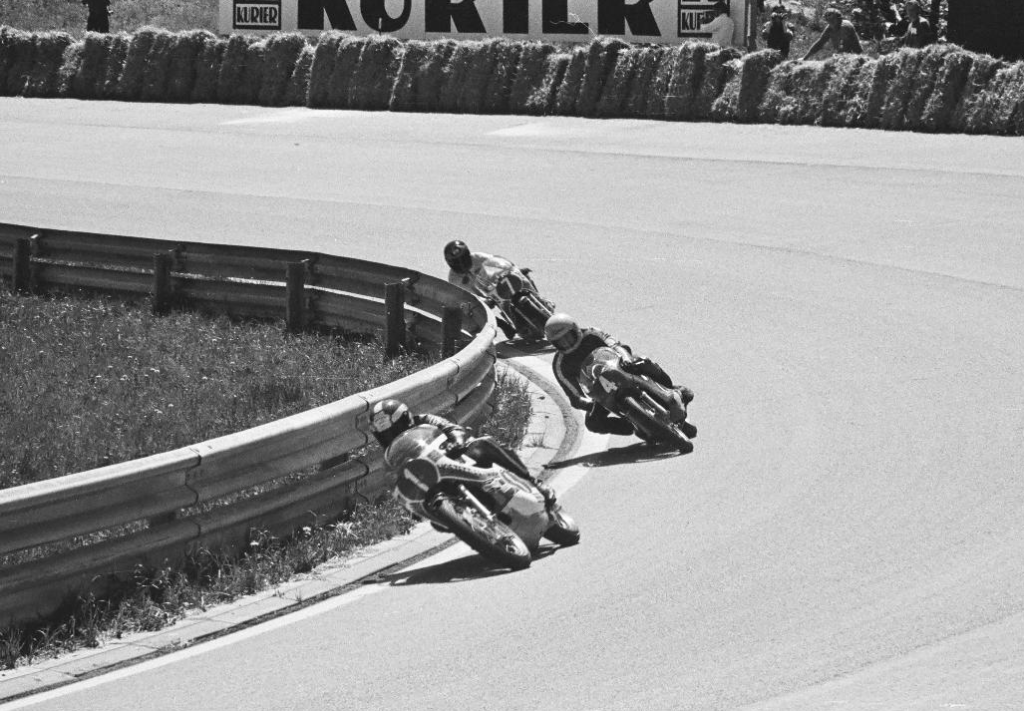
Grand Prix premiere at home race – first point in Finland
His first World Championship race experience took place a week later at the French Grand Prix in Clermont-Ferrand. Chevallier joined a group of riders ahead of him in the 250cc race before mechanical failure ended his race. The two Englishmen Rodney Gould and the very young Barry Sheene were among his competitors at the time. The superstar and world champion was still called Jarno Saarinen this year and came from Finland. The great days of Barry Sheene were yet to come. Olivier Chevallier had the best result at the last GP of the season. At the Finnish Grand Prix in Imatra, the Frenchman achieved an impressive 7th place and scored his first World Championship point. At the time, the world championship point award system was half a science. Depending on the category, only the best 5 or 7 races of a driver per season counted. At the end of the season, Olivier finished 43rd overall in the 250 cm³ class together with 5 other drivers.
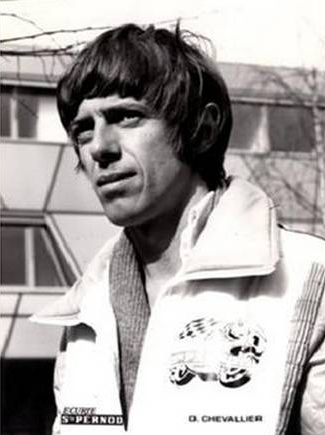
From 1972 also 350cc Grand Prix
For the 1973 season, Olivier Chevallier concentrated on the 350 class and again entered the world championship with a Yamaha. At the end of the season he had 7 points and was 26th in the world championship ranking. In an interview with Moto-Revue magazine, he later said that she was lucky this year. After all, Olivier survived the Grand Prix of Nations on Sunday, May 20, 1973 in Monza. The Italian GP went down in history as one of the darkest days in motorcycle racing when Jarno Saarinen and Renzo Pasolini were killed in the process. Chevallier was also on the starting grid for the race and was one of the chasers of the two leaders. When the accident happened, it was approaching at around 200 km / h when the motorcycles and lifeless bodies of Pasolini and Saarinen were in the middle of the curve. A few days later in Clermont-Ferrand his sponsors abandoned him after taking part in the drivers’ strike and Olivier sold his old 250 and 350 Yamahas.

The brotherly help and the first podium
A move to the French Harley-Davidson team followed in 1974. That year Olivier Chevallier embarked on a trip across the Atlantic to compete in the Daytona 200 Miles. Last year the Finn Jarno Saarinen won on a Yamaha TZ 350 and this year Giacomo Agostini also won on a Yamaha. The journey was not worthwhile for Chevallier, he returned empty-handed. At home, he decided to hire his brother Alain as a mechanic and motorcycle tuner. This collaboration brought him dramatic progress. At the end of the season he was on the podium in the 350 class for the first time after finishing third. In the 10th round of the Spanish GP in Montjuïc (Barcelona). Local hero Víctor Palomo won ahead of the German Dieter Braun (both Yamaha) and Chevallier. In the 250 cm³ class it was enough for World Cup rank 24 with 7 points and in the 350’s he was 15th in the final ranking.
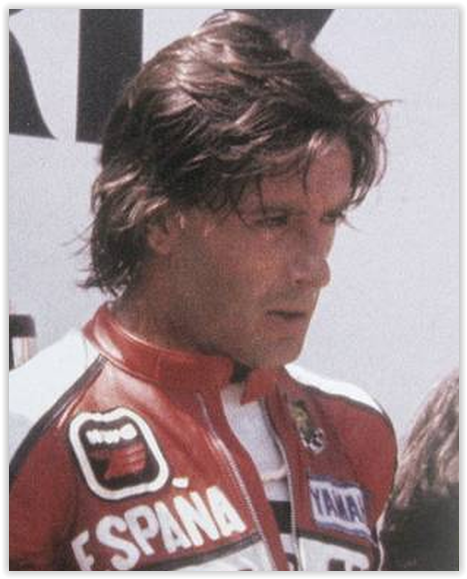
Chevallier and the Big Bikes – Formula 750

Numerous successes in the FIM Formula 750
The series, which was introduced in 1973 and was very popular from the start, allowed motorcycles up to 750 cc. It was something like the European answer to the world-famous Daytona 200, which was driven over a distance of two hundred miles. Since Jarno Saarinen won this prestigious race in 1973, this race has also become increasingly popular in Europe. Many riders even competed with 350-series Yamahas, which in winding passages were more than equal to the 500 cm³ machines and even larger bikes.
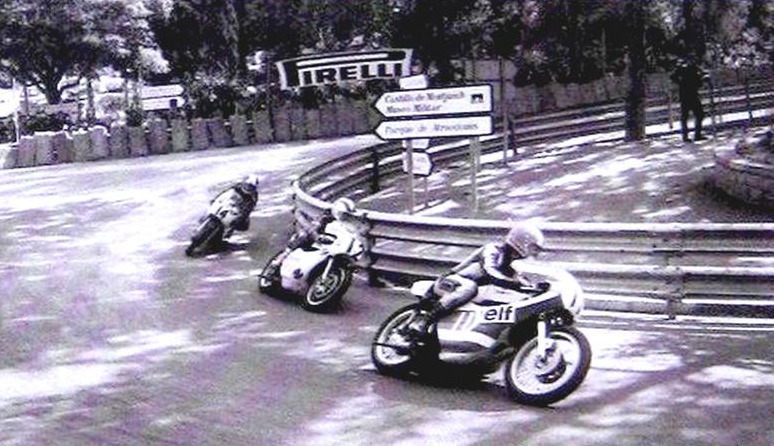
Very successful with the big bikes
Olivier Chevallier successfully participated in this series from 1973 onwards. In the Barcelona race in Montjuich Park at the 750 cc FIM race on October 7, 1973, he finished seventh, behind the Englishman John Dodds, who finished second in the season behind Barry Sheene, the second best driver with a 350 -er Yamaha. Two years later, Olivier took 8th and 4th places in the races in Sweden and Finland. From 1977, the Formula 750 was held as a world championship for three years. The last world champion was Frenchman Patrick Pons in 1979.
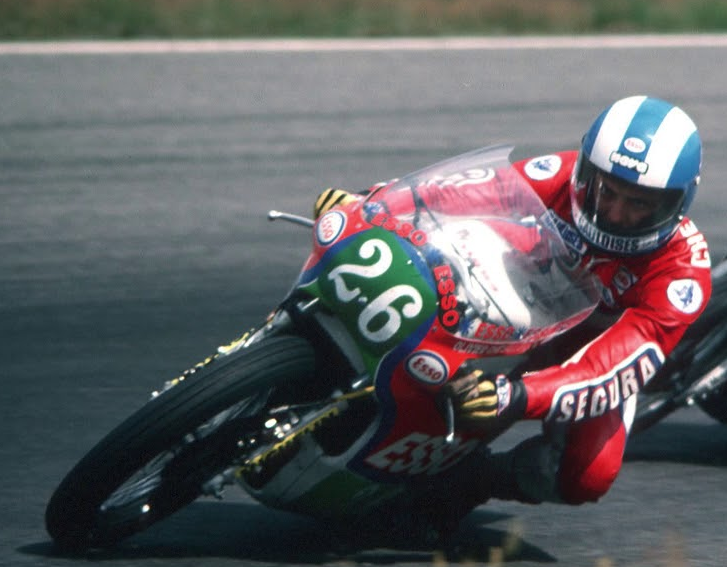
Career kick after military service
After his military service in 1975, Oliver’s career took off. Morale often fell due to many mechanical problems, but the Frenchman was a fighter and never let himself get down. Chevallier also competed in the 500 class this season. In the final calculation of the World Cup he was ranked 20th along with 3 other drivers, including his compatriot Patrick Pons. In the 250s it was only enough for world championship rank 30, together with 4 other drivers.

Far too many fatal accidents
With the Englishman Peter McKinley and the Dutchman Nico van der Zanden two of them did not survive the 1975 season. The Englishman was one of the victims of the Isle of Man, the route on which countless drivers have lost their lives to this day. Two years later, under pressure from numerous drivers, including Barry Sheene, this GP was removed from the calendar and was replaced by the Silverstone GP. The Dutchman van der Zanden from Breda died at the age of 29 in the first 750th Assen race, which was not held as a World Championship run. He had broken his neck in a fall 100 meters from the finish in a collision with a bale of straw and died at the scene of the accident.
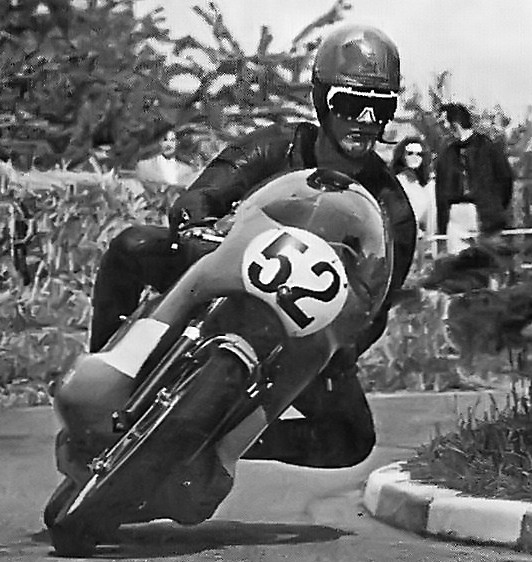
The highlight of the 1975 season in Brno
In the 500cc category Olivier Chevallier made it to 5th place at the GP of Czechoslovakia in Brno. But his season highlight came in 2nd place in the 350s, only the Italian Otello Buscherini was faster than the strong Frenchman. All the classified riders were on a Yamaha. In the 350 cm³ World Championship, he finished 17th with 12 World Championship points behind the South African Jon Ekerold, who had already become a good friend of Olivier. Supported by a new sponsorship by Esso, Olivier bought two new Yamaha Production-Racers in 1976. His brother Alain took care of the preparation again.
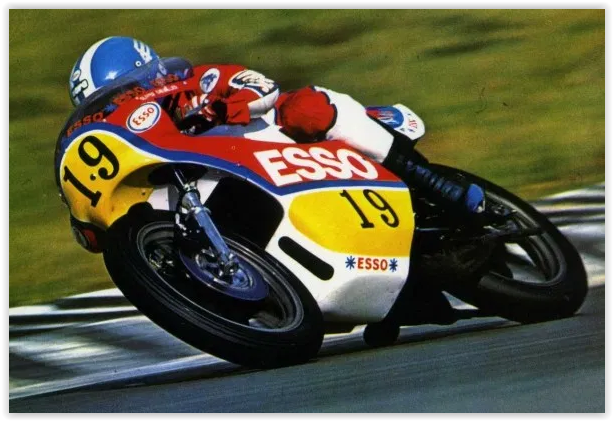
The 1976 season
It was the season that brought Barry Sheene’s breakthrough in the premier class on Suzuki. The Englishman was the superior world champion in the 500 cm³ class. Olivier Chevallier took 29th place in the World Championship this season, together with his friend Jon Ekerold. Fortunately, Alain Chevallier was more there for the technical support of his brother. In the previous year he had devoted himself to car tuning for several months and was therefore often absent. With the confidence, Olivier got more self-confidence again and thus the positive results came again.
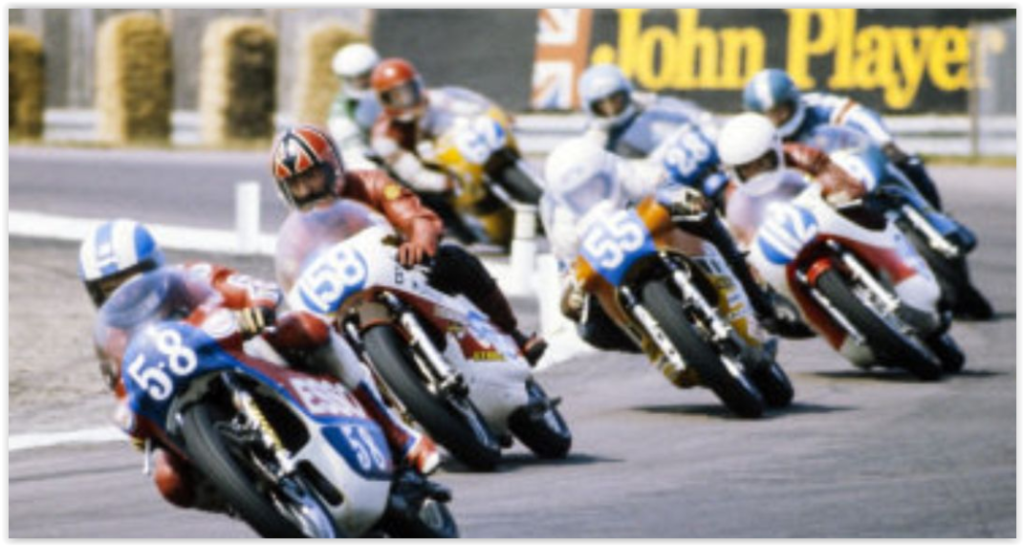
Perfect season opener
The season started promisingly and at the season opener in Le Mans, Chevallier took 5th place in the 350 class. In the 250 cm³ category, he was even able to top this result and with fourth place missed the podium by just 1.21 seconds. On the Salzburgring Olivier managed P7 in the 350s and in Mugello he came ninth in the 250 cc race. After a dry spell until the summer, he came 6th in the 500s in Brno and then 10th at the Nürburgring in the 350 cm³ class.
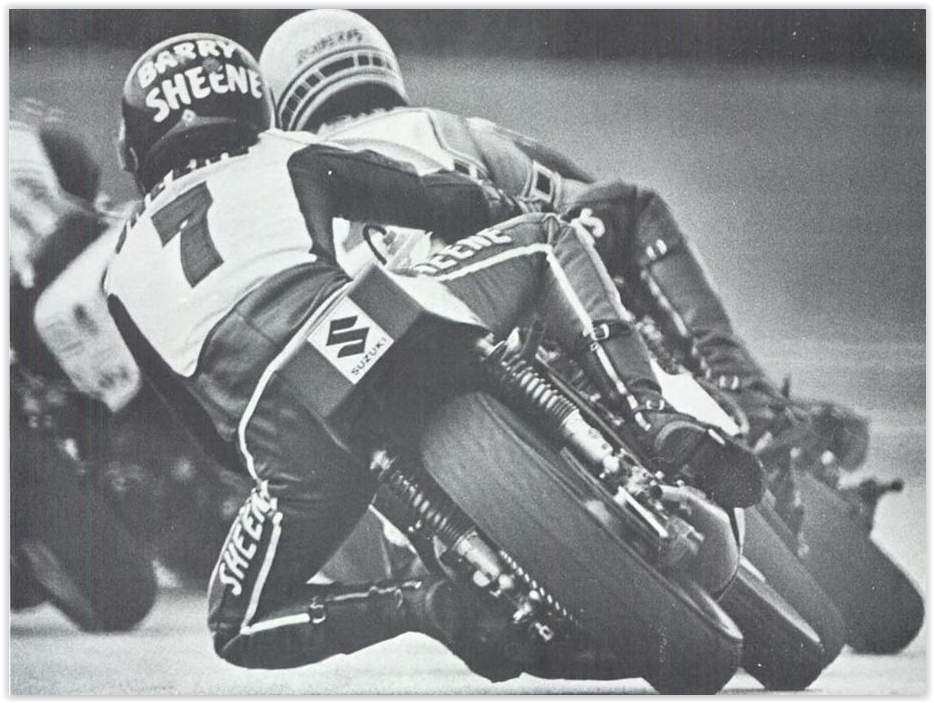
First GP victory
On May 23, 1976, a dream of the likeable French came true. The highlight of the season was definitely the victory in the 350 cm³ class at the GP of Opatija in what was then Yugoslavia (now Croatia). Olivier also set the fastest lap in the race. At the same venue he also achieved a podium in the 250s with 3rd place. In the World Cup it was enough to finish tenth, also here as the most successful French. With 27 points he achieved 9th place in the World Championship in the 350 class, ahead of Franco Uncini, Dieter Braun and Kork Ballington. With his top ten finish at the end of the season, he was the best Frenchman. He had left his compatriots Patrick Pons, Jean-François Baldé and a few other compatriots well behind.
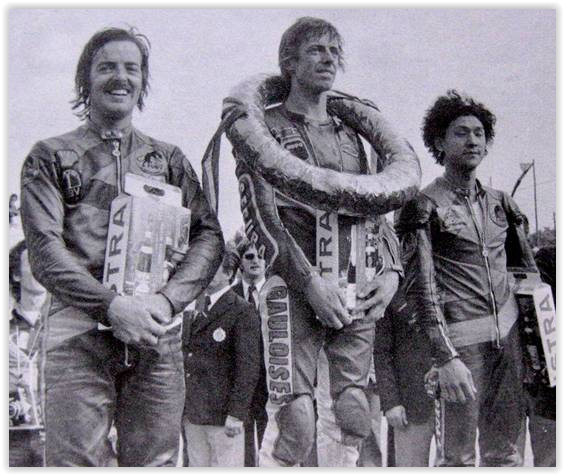
The 1977 season
The trip to the season opener in San Carlos for the Venezuela GP did indeed not particularly pay off for the French. 8th place in the 250 class was the Frenchman’s only haul. Olivier could also have saved himself the trip to the Austrian GP and the scandalous race in 1977. After Franco Uncini and Johnny Ceccotto suffered serious falls, the 350 race was stopped much too late, despite a fatal accident caused by the Swiss Hans Stadelmann. The 250 cm³ class was not carried out in the first place and all drivers with brains and respect boycotted the 500 series. In Hockenheim at the German GP, Chevallier took third place in the 350 cc category for the refusal to start for the German GP in his first 1972 World Championship season at the Nürburgring in his own way. In the race after next, he finished 8th in the same category at the French GP. His last race in his young life was to take place 3 years later on the Paul Ricard Circuit in Le Castellet.
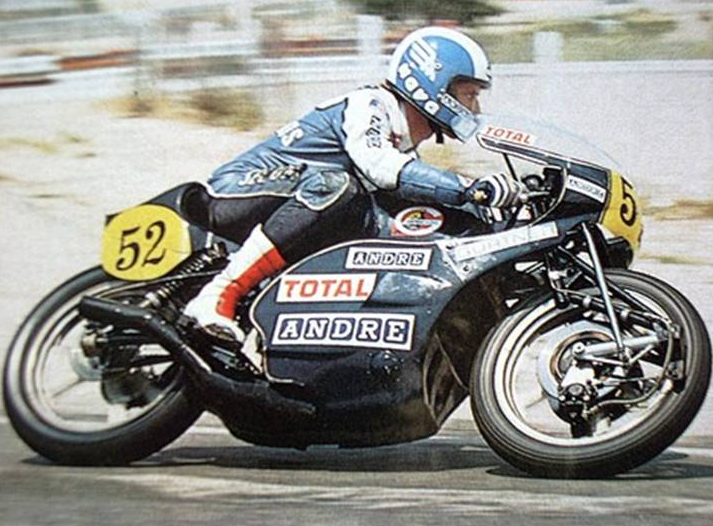
Best World Championship classification of his career
In Assen he finished 7th and at the GP of Finland it was enough for P6. Then at the GP of Czechoslovakia in Brno, 9th place in the 250s. At the British Grand Prix in Silverstone, Olivier made it onto the podium for the second time this year, behind South African Kork Ballington. In 1977 Chevallier was 6th in the final ranking in the 350 cm³ class of the world championship, he was never classified so well before. In the 250 cm³ class he was 13th, ahead of compatriot Christian Sarron. With a 3rd place in the Spanish Grand Prix at Jarama, behind the winner Takazumi Katayama and Alan North from South Africa, he had also achieved a podium in the middle class.
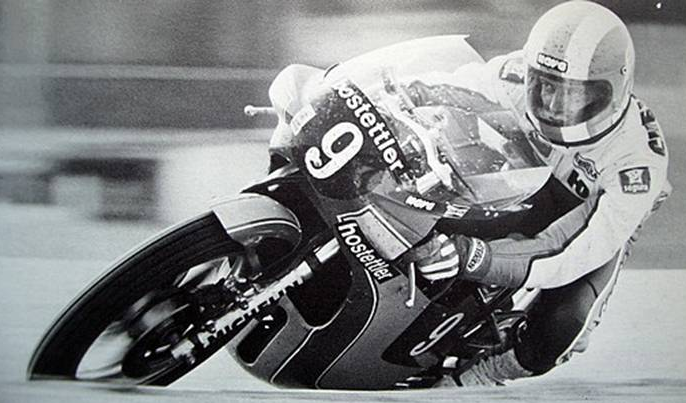
1978 – the penultimate World Cup season
Chevalliers Olivier Chevallier achieved in the opening round of the 1978 season at the Venezuela GP in San Carlos a 4th place in the 250 cc category. At the Spanish Grand Prix in Jarama he achieved seventh place. In the 3rd round of the World Championship at the Austrian GP in Salzburg, he entered the 350 cm³ class for lack of a 250-runner and came in good fifth. At the home race in Nogaro, the Frenchman made it into the points both times with 7th place in the 350s and 8th up to 250 cm³. After P8 in Mugello (350 cm³), 3 World Championship rounds followed without points. It was only in Imatra and Silverstone that things went up again with ranks 8 to 350 cm³. In the 250s it was even enough for 5th place at the British GP. A conciliatory reunion with the Nürburgring brought Olivier 7th place in the 350 cm³ category at the season finale. The World Cup ranks 12 (250 cm³) and 10 (350 cm³) were again able to be seen.
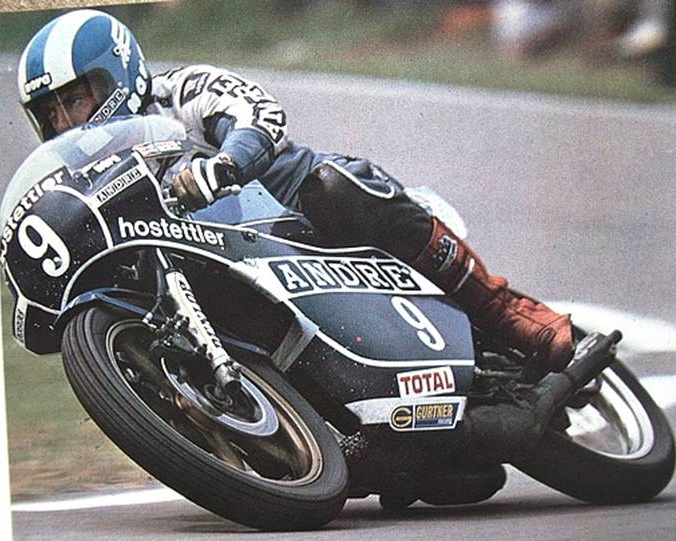
1979 – Chevalliers’ final GP season
The season opener this year took place again in Venezuela and for Olivier his last GP season started not badly with 9th place in the 350 class. The category up to 250 cm³ brought the best result of the entire season with 4th place in the first round. It was followed by such a tough dry spell as never before for the French, with 5 laps without World Championship points. The competition had grown stronger, both from their own country and from the factory entry of Kawasaki. Only at the Assen GP in the 7th lap did Chevallier again achieve a countable result with 9th place in the 350s.

At the Swedish GP in Karlskoga, he repeated this classification in the 250 race two laps later. Another 2 laps after that there was another highlight in Silverstone with P7 in the 350s, which he even managed to top with 6th place in the 250 cm³ class. At the home race for the French GP in Le Mans, Olivier competed for the last time in the World Cup and took 8th place to 250 cm³. With the World Championship ranks 11 (250 cm³) and 20 (350 cm³), the Frenchman withdrew from Grand Prix racing at the end of the year.
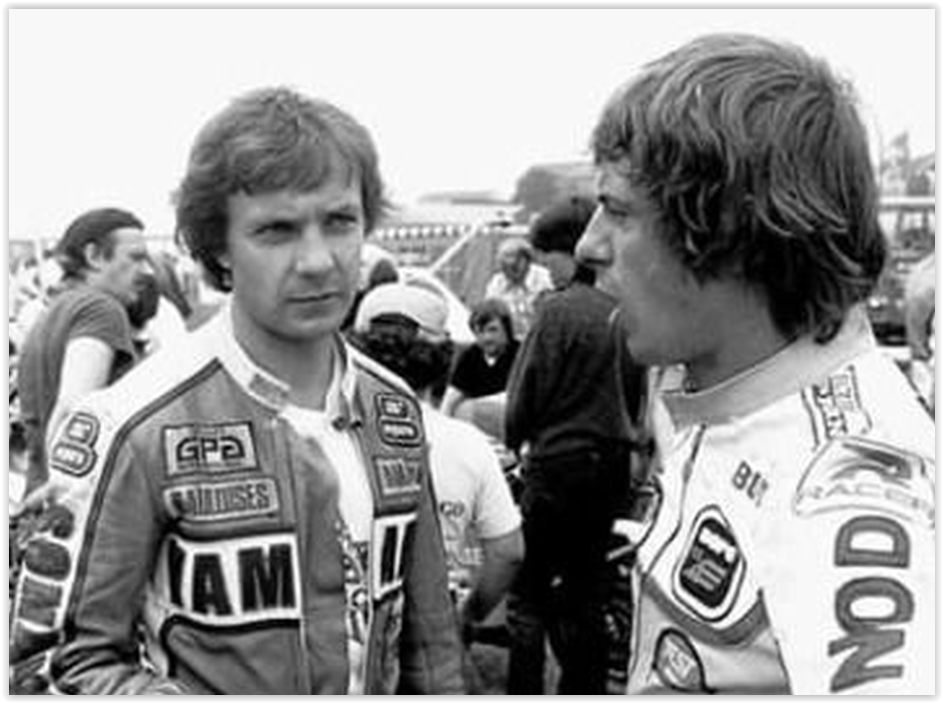
Chevaliers last race

On April 6, 1980, during the race for the “Moto Journal 200” on the Paul Ricard circuit near Cannes, the catastrophic crash occurred. The accident in the 250 cm³ class of the national race occurred in the corner “Verrerie”, a chicane after the start-finish. Olivier Chevallier died in Le Beausset Hospital near Toulon at the age of 31 from a chest trauma. With his blond hair and almost always in a good mood and extremely humorous, most who knew him have fond memories of him. With Olivier, one of the most popular racing drivers in France left us much too early. Only half a year later, after the fatal accident of his compatriot and friend Patrick Pons, the next bad news for fans of motorcycle racing followed.
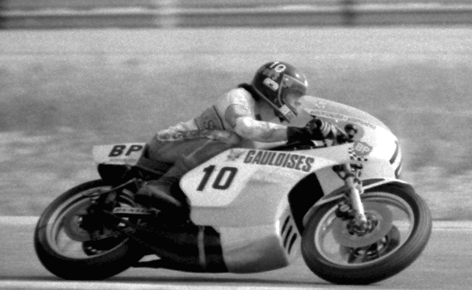

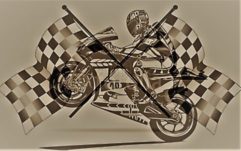
Thank you for remembering Olivier.
In 1965, after exiting a school examination for all 15 yr-olds in St. Cloud, just outside Paris, I met another student, Olivier Chevallier. Sure enough, he had his Motobi 50; it was red, I believe. I was on a souped-up Peugeot Sport 50 with a Dell’Orto carb. He challenged me (or we challenged each other) to a drag (straight-line) race. His bike had a double-cradle frame, mine a homely single spine holding up the engine and a 3-spd hand shift. I actually don’t remember who won, but imagine it would’ve him. I remember following his career a bit, particularly after he joined the “Jeunes Tigres”, racing a Mondial Monneret 50, that a friend of mine also joined. I’d moved to the US by 1978 and later learned from that friend that Olivier had died. Sad, indeed.